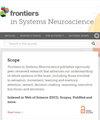Sex-Specific Neural Networks of Cued Threat Conditioning: A Pilot Study
IF 3.1
4区 医学
Q2 NEUROSCIENCES
引用次数: 8
Abstract
Cued threat conditioning is the most common preclinical model for emotional memory, which is dysregulated in anxiety disorders and post-traumatic stress disorder. Though women are twice as likely as men to develop these disorders, current knowledge of threat conditioning networks was established by studies that excluded female subjects. For unbiased investigation of sex differences in these networks, we quantified the neural activity marker c-fos across 112 brain regions in adult male and female mice after cued threat conditioning compared to naïve controls. We found that trained females engaged prelimbic cortex, lateral amygdala, cortical amygdala, dorsal peduncular cortex, and subparafasicular nucleus more than, and subparaventricular zone less than, trained males. To explore how these sex differences in regional activity impact the global network, we generated interregional cross-correlations of c-fos expression to identify regions that were co-active during conditioning and performed hub analyses to identify regional control centers within each neural network. These exploratory graph theory-derived analyses revealed sex differences in the functional coordination of the threat conditioning network as well as distinct hub regions between trained males and females. Hub identification across multiple networks constructed by sequentially pruning the least reliable connections revealed globus pallidus and ventral lateral septum as the most robust hubs for trained males and females, respectively. While low sample size and lack of non-associative controls are major limitations, these findings provide preliminary evidence of sex differences in the individual circuit components and broader global networks of threat conditioning that may confer female vulnerability to fear-based psychiatric disease.提示威胁条件反射的性别特异性神经网络:一项初步研究
提示威胁条件反射是情绪记忆最常见的临床前模型,在焦虑症和创伤后应激障碍中情绪记忆失调。尽管女性患这些疾病的可能性是男性的两倍,但目前对威胁条件网络的了解是通过排除女性受试者的研究建立的。为了对这些网络中的性别差异进行公正的研究,我们量化了成年雄性和雌性小鼠在提示威胁条件下与天真的对照组相比在112个大脑区域的神经活动标记c-fos。我们发现,受过训练的女性比受过训练的男性更多地参与胸前皮质、外侧杏仁核、皮质杏仁核、背侧脚脚皮质和腹下核,而腹下区的参与更少。为了探索区域活动中的这些性别差异如何影响全球网络,我们生成了c-fos表达的区域间交叉相关性,以确定在条件作用过程中共同活动的区域,并进行了中枢分析,以确定每个神经网络中的区域控制中心。这些探索性图论衍生的分析揭示了威胁条件网络功能协调的性别差异,以及受过训练的男性和女性之间不同的中枢区域。通过顺序修剪最不可靠的连接构建的多个网络的中枢识别显示,苍白球和腹侧隔膜分别是受过训练的雄性和雌性最强大的中枢。虽然低样本量和缺乏非关联对照是主要的局限性,但这些发现提供了初步证据,表明单个电路组件和更广泛的全球威胁条件网络存在性别差异,这可能会使女性容易患上基于恐惧的精神疾病。
本文章由计算机程序翻译,如有差异,请以英文原文为准。
求助全文
约1分钟内获得全文
求助全文
来源期刊

Frontiers in Systems Neuroscience
Neuroscience-Developmental Neuroscience
CiteScore
6.00
自引率
3.30%
发文量
144
审稿时长
14 weeks
期刊介绍:
Frontiers in Systems Neuroscience publishes rigorously peer-reviewed research that advances our understanding of whole systems of the brain, including those involved in sensation, movement, learning and memory, attention, reward, decision-making, reasoning, executive functions, and emotions.
 求助内容:
求助内容: 应助结果提醒方式:
应助结果提醒方式:


